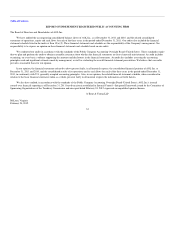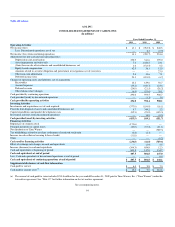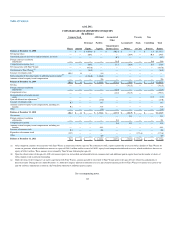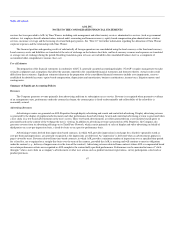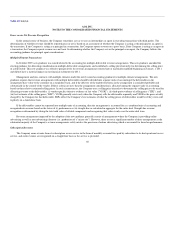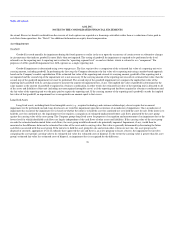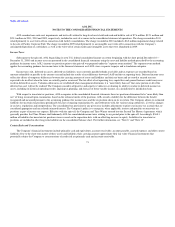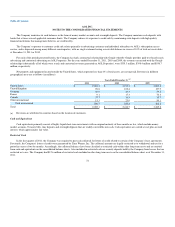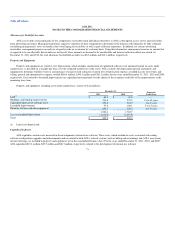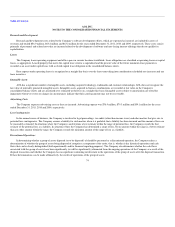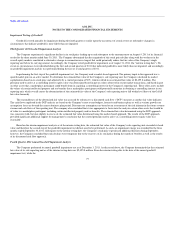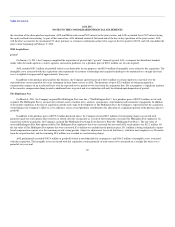America Online 2011 Annual Report Download - page 74
Download and view the complete annual report
Please find page 74 of the 2011 America Online annual report below. You can navigate through the pages in the report by either clicking on the pages listed below, or by using the keyword search tool below to find specific information within the annual report.
Table of Contents
AOL INC.
NOTES TO THE CONSOLIDATED FINANCIAL STATEMENTS
the award. Excess tax benefits realized from the exercise of stock options are reported as a financing cash inflow rather than as a reduction of taxes paid in
cash flows from operations. See "Note 8" for additional information on equity-based compensation.
Asset Impairments
Goodwill
Goodwill is tested annually for impairment during the fourth quarter or earlier in the year upon the occurrence of certain events or substantive changes
in circumstances that indicate goodwill is more likely than not impaired. The testing of goodwill for impairment is required to be performed at the level
referred to as the reporting unit. A reporting unit is either the "operating segment level" or one level below, which is referred to as a "component." For
purposes of AOL's goodwill impairment test, AOL operates as a single reporting unit.
Goodwill impairment is determined using a two-step process. The first step involves a comparison of the estimated fair value of a reporting unit to its
carrying amount, including goodwill. In performing the first step, the Company determines the fair value of its reporting unit using a market-based approach
based on the Company's market capitalization. If the estimated fair value of the reporting unit exceeds its carrying amount, goodwill of the reporting unit is
not impaired and the second step of the impairment test is not necessary. If the carrying amount of the reporting unit exceeds its estimated fair value, then the
second step of the goodwill impairment test must be performed. The second step of the goodwill impairment test compares the implied fair value of the
reporting unit's goodwill with its carrying amount to measure the amount of impairment loss, if any. The implied fair value of goodwill is determined in the
same manner as the amount of goodwill recognized in a business combination. In other words, the estimated fair value of the reporting unit is allocated to all
of the assets and liabilities of that unit (including any unrecognized intangible assets) as if the reporting unit had been acquired in a business combination and
the fair value of the reporting unit was the price paid to acquire the reporting unit. If the carrying amount of the reporting unit's goodwill exceeds the implied
fair value of that goodwill, an impairment loss is recognized in an amount equal to that excess.
Long-lived Assets
Long-lived assets, including finite-lived intangible assets (e.g., acquired technology and customer relationships), do not require that an annual
impairment test be performed; instead, long-lived assets are tested for impairment upon the occurrence of an indicator of impairment. Once an indicator of
impairment has occurred, the impairment test is based on whether the intent is to hold the asset for continued use or to hold the asset for sale. If the intent is to
hold the asset for continued use, the impairment test first requires a comparison of estimated undiscounted future cash flows generated by the asset group
against the carrying value of the asset group. The Company groups long-lived assets for purposes of recognition and measurement of an impairment loss at the
lowest level for which identifiable cash flows are largely independent of the cash flows of other assets and liabilities. If the carrying value of the asset group
exceeds the estimated undiscounted future cash flows, the asset group would be deemed to be potentially impaired. Impairment, if any, would then be
measured as the difference between the estimated fair value of the asset and its carrying value. Fair value is generally determined by discounting the future
cash flows associated with that asset group. If the intent is to hold the asset group for sale and certain other criteria are met (i.e., the asset group can be
disposed of currently, appropriate levels of authority have approved the sale and there is an active program to locate a buyer), the impairment test involves
comparing the asset group's carrying value to its estimated fair value less estimated costs of disposal. To the extent the carrying value is greater than the asset
group's estimated fair value less estimated costs of disposal, an impairment loss is recognized for the difference.
70



